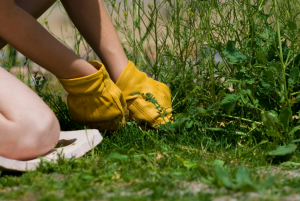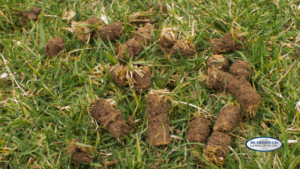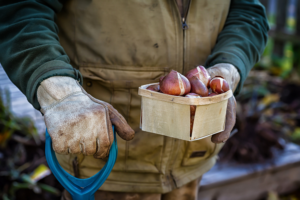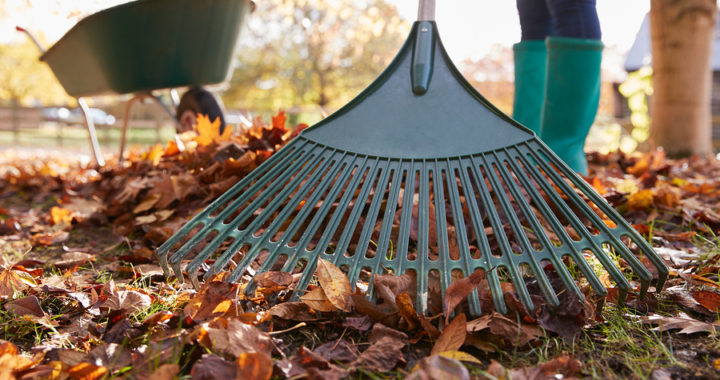While none of us want to think about getting ready for winter quite yet, fall is upon us, and that means it’s time to start preparing our yards for the colder months to come. Taking the time to prep your yard and gardens now will result in a fuller lawn and healthier plants when spring rolls around again.
Take care of these 7 fall yard cleanup tasks now and reap the benefits of a lush and beautiful yard next spring.
1. Rake and Mulch
Rake regularly throughout the fall to remove dead leaves and other debris that smother grass and prevent growth. Fallen leaves and weeds can also become a haven for pests and can damage your yard’s drainage, which will cause problems when the snow melts in the spring.
Among other benefits, adding mulch to your plants in the fall helps prevent soil erosion and suppress weeds. Lay a 2-3 inch layer of mulch around trees, shrubs, perennials, and cool-weather annuals to keep them healthy through the winter. Using organic mulch options like pine needles, straw, grass clippings, and mulched leaves can save you money and add essential nutrients back into the soil.
2. Clean Up Garden Beds

Clear out flower beds before the ground freezes by removing all leaves, weeds, and other debris that can invite insects and disease. Pay special attention to rose beds as their leaves can be prone to disease over the winter.
For vegetable gardens, pull out old plants and remove debris after the final harvest of the year, then add a layer of compost. Once the ground freezes, trim perennial vegetables and herbs back a few inches.
3. Prune Trees and Shrubs
Dead branches can be a liability in the winter, as heavy snow can cause them to break and fall into your yard. Trim dead branches and cut back overgrowth on trees, shrubs, and bushes. Cut cracked, loose, or diseased limbs close to — but not quite flush with — the trunk, leaving the wounds exposed to heal. Now is also the time to prune spring-blooming perennials like lilacs or forsythia.
4. Aerate and Feed the Lawn

Excess thatch or debris under the surface of your grass can starve the roots of essential nutrients. Aerating your lawn removes thatch, loosens compacted soil, and results in healthier, more beautiful grass.
Aerating compressed soil helps keep rainwater from pooling, allowing water and nutrients to reach the roots of your grass. For small yards, a garden fork or spiked lawn aerator shoes will do the trick, but for larger yards a walk-behind aerator may be necessary. If you don’t want to purchase an aerator, you can rent one from most local hardware stores.
Grass roots continue growing until the ground reaches temperatures of around 40 degrees, so keep feeding your lawn until then. Using a high-phosphorus fertilizer in the fall will encourage root growth so your grass greens up more quickly in the spring.
5. Do a Final Mow
To help your lawn finish strong for the year and grow lush and green in the spring, continue watering and mowing as needed throughout the fall.
Once the end of the season nears and temperatures start to drop, you’ll want to mow your grass shorter than usual. For the last two cuts of the season, mow with your mower’s blades on their lowest setting (around 1 ¼ inches is ideal). Doing so allows the soil to dry out faster in the spring for a lusher lawn.
6. Divide Perennials and Plant Bulbs and Shrubs

Cut back perennials in the fall, trimming spent foliage down to the ground. This way, the plant will send all of its energy to the roots for better growth next season.
Divide thriving perennials in the fall as well, adding them to other beds or sharing them with friends and neighbors. Giving them more space allows them to continue growing full and healthy. One exception to this rule: fall-blooming perennials like chrysanthemums should be divided in the spring. In addition, tuberous plants like irises and daylilies can be divided every three years to give them more space to grow.
New shrubs or spring-blooming bulbs like daffodils can be planted in the fall. Planting them early in the fall allows them to establish their roots before winter. While you’re at it, consider planting fall annuals like pansies to keep some color going in your gardens a little while longer.
7. Dry Out Hoses and Irrigation Systems
Drain water from hoses and drip irrigation systems to avoid damage during the winter. Standing water inside hoses and tubing can freeze, causing them to crack. Pro tip: to easily expel water from a simple drip irrigation system, first turn off the water, then use an air compressor at a low setting to blow the water out.
McDonough’s Fall Planting Bed Cleanup Services Can Help Make Your Fall Yard Cleanup a Breeze
Don’t have the time to properly clean out your garden beds this fall? Take advantage of McDonough Landscaping’s fall planting bed cleanup services for easier fall yard cleanup. We’ll prune back perennial growth, prune shrubs and ornamental trees as needed, and remove any leaves that have fallen.
